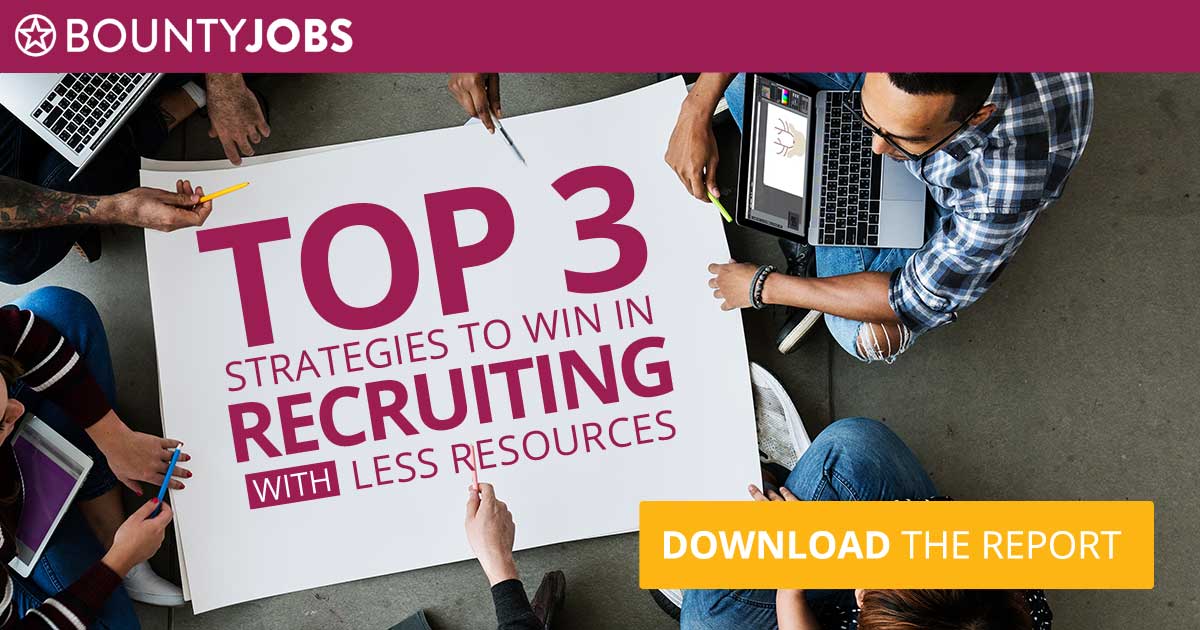Top 3 Strategies to Win in Recruiting with Less Resources
It’s an interesting time in talent acquisition! The unemployment rate is down to historic lows and job volume and wage growth are said to be on the incline. Still, hiring resources are flat or even less than they were last year. The theme of ‘doing more with less’ is quickly become a standard rather than a trend. We took a look at strategies to apply to better ensure a productive recruiting plan:
- Adopt Technology or Become Obsolete
- Non-Traditional Actions to Evolve Your Recruiting Strategy
- Unique Ways to Stand Out from the Competition
Applicants know they are in a ‘candidate-driven market’ and the competition is lurking around every corner. Recruiting processes have to be lock-tight in every area to stay ahead. Download your free report now!
BountyJobs Bites
Time-to-Hire Top Concern for Growing Companies
Per the 2018 Growth Hiring Trends in the United States from Spark Hire, 25% of companies responding predicted workforce growth this year with staffing challenges such as time-to-hire.
49% of survey respondents stated that a week or two from applying to the offer letter was average, while 24% stated that 15-30 days was the norm.
Women Not Given the Welcome Wagon in STEM Fields
A report from two Stanford University researchers, ‘Puncturing the Pipeline: Do Technology Companies Alienate Women in Recruiting Sessions?’ found that companies are giving off a ‘chilly environment’ for female STEM candidates. The analysts attended recruitment sessions and found that 84% had mostly male presenters, 24% had no women presenters, and 58% had women in marginalized roles. A mere 22% had female engineers presenting ‘core technical content’.
Extended Sick Leave Plans Bring Better ROI
The study, ‘How Many Sick Days Are Enough?’ found that workers in the U.S. utilize preventive care 26% to 85% more when they have 10 or more paid sick leave days. This is in comparison to those with zero to two days leave. Paid sick leave in the U.S. is not automatically offered, with only 72% of workers having it included in their benefits.
Financial Education and Products Valued by Staff
A new survey by Prudential Financial Inc. found that 80% of employees felt that employers should include opportunities to help them succeed. Examples given were financial products, health and wellness programs financial education, etc. Millennials cite student debt as their biggest financial blocker while Baby Boomers and Gen Xers felt that slow wage growth was theirs.
Four Recommended Investments in Your Workforce
In their new whitepaper, ‘Tax Reform Investment Opportunity’, Mercer looks at additional ways that companies could invest in their workforce via the financial windfall the recent corporate tax cuts may supply. In addition to share repurchases, dividends, M&A, debt repayment, and capital investments, the report states that investing in building a ‘workforce for the future’ will help ensure they pull ahead of the competition.
Wage Growth Correlates to Demographics
A recent report from the Economic Policy Institute finds while wage increases have been enjoyed by many, for some they are merely catching up to where they should have been long ago. Increases were uneven across ‘racial, gender and other demographic lines’ and found that the gap is widening between high and low wage earners.
California Tops with Highest Average Weekly Wage
Santa Clara County ranked first in the highest average weekly wage in the third quarter among large U.S. counties at $2,320. The top 5 counties are:
- Santa Clara, Calif.: $2,320
- San Mateo, Calif.: $2,123
- San Francisco, Calif.: $1,954
- New York, NY: $1,889
- Washington, DC: $1,759
Beige Book Reviews Worker Shortages and Wage Growth
Construction, IT and Manufacturing led the list of worker shortages within the latest Beige Book report.
“Across the country, contacts observed persistent labor market tightness and brisk demand for qualified workers, as well as increased activity at staffing placement services,” according to the report.
Jobless Claims Average Increase
“The US four-week moving average of initial claims for unemployment insurance rose to 222,500 last week, up 2,000 from the previous week’s unrevised average, the US Department of Labor reported. The four-week moving average decreases the volatility of the weekly numbers. Total initial claims for unemployment insurance for the week ended March 3 rose to 231,000, up 21,000 from the previous week’s unrevised level.”
Market Still Healthy in Spite of Fewer Jobs Added in February
US private sector employment rose by 235,000 jobs in February, down from the gain of 244,000 in January but still “red hot,” according to the ADP National Employment Report.
“The labor market continues to experience uninterrupted growth,” said Ahu Yildirmaz, VP and co-head of the ADP Research Institute. “We see persistent gains across most industries with leisure and hospitality and retail leading the way as consumer spending kicked up. At this pace of job growth, employers will soon become hard-pressed to find qualified workers.”
Diversity Still Lacking in Hiring
Per a recent survey from Randstad U.S., 47% of male and 45% of female employers stated their companies were diversity employers of choice. An overwhelming majority of almost 80% of respondents felt that equal treatment regardless of gender, sexual orientation, age, race or religion was important to them. According to respondents, more than half of companies could do more to promote gender equality and diversity.
U.S. Wage Growth Increase in February with San Francisco Fastest Growth
“US wage growth accelerated slightly in February, according to data from Glassdoor. The annual median base pay in the US grew 1.0% year over year in February to $51,975, up from the 0.6% revised pay growth in January. Pay growth peaked more than a year ago in January 2017 at a revised 3.4%. Among the 10 metros tracked, wage growth was fastest in San Francisco, up 3.1% to $69,276, and Washington, DC, up 1.9% to $59,780. Houston, which saw slow to negative wages in 2017, was up 1.3% in February to $55,621. Chicago growth remained flat at $56,304.”
U.S. Nonmanufacturing Declines in February
“Economic activity in the US nonmanufacturing sector decelerated slightly in February, according to the Institute for Supply Management’s nonmanufacturing index, released today. ISM’s nonmanufacturing index edged down in February to a reading for 59.5 from January’s reading of 59.9. Readings above 50 generally indicate improving conditions.”










